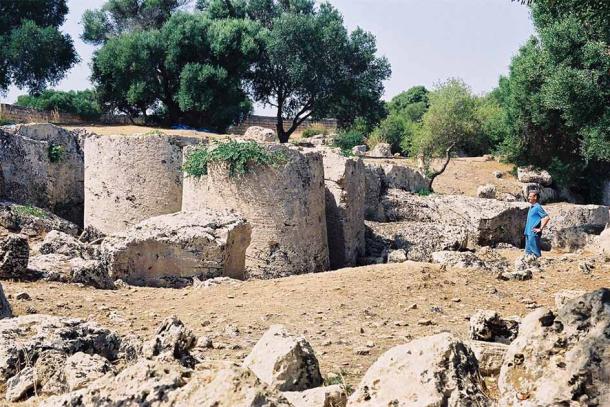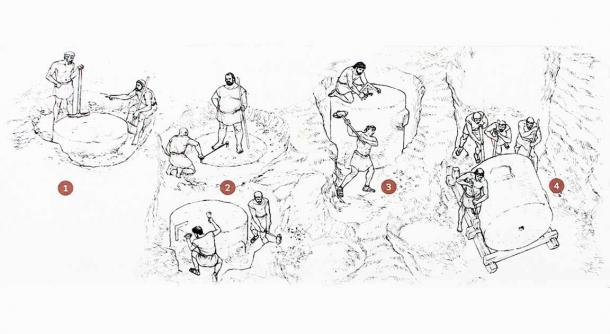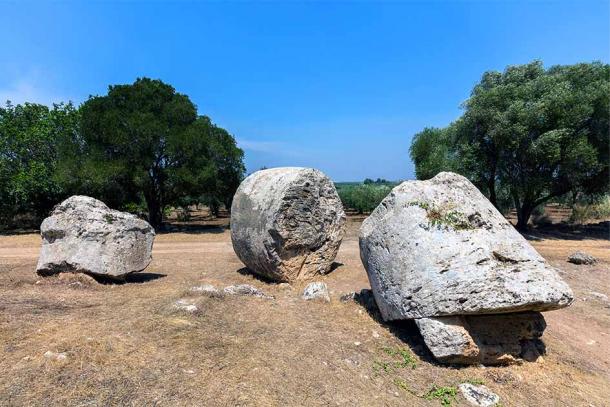Hidden Gems of Sicily: The Abandoned Temple Columns of Cave di Cusa
The cave Di Cusa situated in Sicily is the Mediterraneans best kept secret from the ancient past because this particular megalithic site shows clear signs of advanced machining on its gigantic cylindrical pillar sides.
If someone told you that you could effortlessly travel back in time to classical antiquity, you would think that they were crazy, right? But at Cave di Cusa, in Sicily, this is actually possible. This Greek rock quarry was abruptly abandoned mid-workday and never reclaimed. Frozen in time just as it was, it remains so to this day. Visiting this vital archaeological site should not be missed when exploring southern Sicily. It offers a rare window onto the past and is one of the region’s most popular tourist destinations.

The remains of raw columns for a Selinunte temple at the Cave di Cusa quarry in Sicily. (CC0)
Exploring Cave di Cusa: A Fascinating Window into the Past
Sicily is a true hotbed of ancient archeological remains. Once populated by ancient Greeks in their colonies, it was always at the crossroads of history, witnessing all the major changes and the passing of different civilizations. Cave di Cusa is a prime example of this phenomenon.
- Archaeologists in Sicily Excavate a Remarkably Well-Preserved Ancient Greek City
- Sicily: Where Cultures and Histories Converge and Giants Roam
In classical antiquity, this ancient rock quarry was used for many decades as the main stone quarry in the region. Situated on a ridge that spans east to west, it is around 1.8 kilometers (4.97 miles) long. Archeological research revealed that the first work done in this quarry was conducted around the first half of the 6th century BC.
The stone extracted at Cave di Cusa was of excellent quality, meaning that the limestone had the ideal texture and hardness. Thus, it was prized by the ancient Greeks who used the stone for the construction of their lavish temples and buildings.
Just 13 kilometers (about 8 miles) away from the Cave di Cusa quarry is the site of ancient Selinunte, a rich and prosperous ancient Greek city that boasted many impressive temples. Over many generations, the stone used in Selinunte was quarried at Cave di Cusa. It was one of the largest Greek cities in Sicily, at its height its residents numbered around 30,000. The high demand for its precious stone meant that Cave di Cusa quarry always worked at full speed and capacity.
Research shows that between 150 and 200 workers – mostly slaves – worked busily at the quarry throughout its history. Great Doric columns were carved here – in situ – before being transported to Selinunte where they’d adorn the lavish temples. But the quarry’s rich and industrious history suddenly and unexpectedly came to an end – forever.

The Temple of Hera in Selinunte, Sicily, was built using stone quarried at Cave di Cusa. (Bellafiore Franco / Adobe Stock)
The Arrival of the Carthaginian Invaders
Research shows us that the quarry of Cave di Cusa was worked extensively for around 150 years. But it was abandoned suddenly, at a moment’s notice. This occurred in 409 BC, when the area was invaded by the Carthaginian general Hannibal Mago, not to be confused with the more famous Hannibal who lived two centuries later.
As the invasion swept through the Cave di Cusa quarry, the panicked slaves and overseers swiftly fled, not daring to look back. The quarry was left in disarray, abandoned in the middle of a workday, and left untouched from that point forward. No one ever returned to reclaim it.

The remains at Cave di Cusa provide much-needed information about how these ancient builders went about creating the columns used in their spectacular architecture still visible today on the island of Sicily. (Davide Mauro / CC BY-SA 4.0)
Whatever task they were working on when they fled was left untouched, exactly as it was. As a result, visitors can now physically step back into 409 BC, precisely at the moment when the quarry was abandoned. Great temple drums lie unfinished, as do column bases and pillars. The sudden halt in activity has been preserved the site, allowing us to witness the ancient past in its entirety, centuries later.
Cave di Cusa is particularly beautiful during springtime, when the gentle breeze sways the grass and the surrounding flowers burst into bloom. The combination of natural beauty and ancient ruins creates a quaint and picturesque atmosphere, drawing in many tourists from around the world. Visitors can indulge in a picnic amidst the scenic landscape while contemplating the nature of history and the passage of time evident in these archaeological remains.

The quarry from above, identifying the remains of raw columns destined for Selinunte, at Cave di Cusa in Sicily by the 18th-century French painter and engraver Jean-Pierre Houël. (Public domain)
An Archaeologist’s Dream: Cave di Cusa as Testament to Sicily’s Tumultuous History
Cave di Cusa’s exceptional history, particularly its sudden evacuation, makes it an ideal location for modern archaeologists. Approximately sixty massive and mostly-cylindrical stone blocks, intended for the creation of imposing temple columns, are scattered across the site.
While some of the blocks were only partially carved, others are almost finished, allowing for an in-depth study of the construction process of these ancient architectural elements. This unique feature makes Cave di Cusa an excellent location for archaeological education and research.
Another great insight is the wealth of tool marks on the stone, which have allowed researchers to study in detail the method of quarrying rock at Cave di Cusa in this ancient period. What is more, there are numerous examples of unique technological solutions to make the stone-working easier. One case in point are carefully placed grooves and holes that would make the lifting of these blocks much easier.

The remains of abandoned stone destined for Selinunte at the Cave di Cusa quarry in Sicily. Source: V. Korostyshevskiy / Adobe Stock
All of these discoveries are a clear indication that during its heyday the Cave di Cusa quarry was a very important site, valuable to the rich inhabitants of Selinunte who could boast about their many lofty temples mainly thanks to the hard work done at the quarry.
Alas, it was the Carthaginians who put an end to the industry done here when they invaded Sicily during the First Punic War between Rome and Carthage. Selinunte itself suffered extensive damage during the attack, and its defenders were all executed. The city was eventually abandoned in 250 BC and never resettled again.
Cave di Cusa remains one of the most valuable archeological sites for studying Sicily’s past and understanding its ancient Greek history. The quarry, together with the nearby city of Selinunte, is crucial evidence of the devastating Carthaginian invasion of 409 BC, whose army is said to have numbered 100,000 soldiers by some estimates.
In light of the historical context surrounding the Carthaginian invasion and the ensuing conflict, it is understandable why the Cave di Cusa quarry was abandoned so suddenly. The chaos of the invasion would have undoubtedly caused panic, leading workers to abandon their tasks and flee for their lives. The abandoned quarry stands today as a remarkable testament to the tumultuous history of the region and provides a unique window into the construction techniques and methods of the ancient world.
Related Post
A shocking documentary proves that mermaids do exist
SHOCKING Revelation: Thuya, Mother of Queen Tiye, Was the Grandmother of Akhenaten and Tutankhamun—What Ancient Egyptian Secrets Did She Leave Behind?
Breaking News: Astonishing Discoveries at Karahan Tepe Confirm an Extraterrestrial Civilization is Hiding on Earth, and NO ONE Knows!
Breaking News: Researchers FINALLY Discover U.S. Navy Flight 19 After 75 Years Lost in the Bermuda Triangle!
NASA’s Secret Investigation: Uncovering the Astonishing Mystery of the UFO Crash on the Mountain!
Explosive UFO Docs LEAKED: Startling Proof That Aliens Ruled Ancient Egypt!